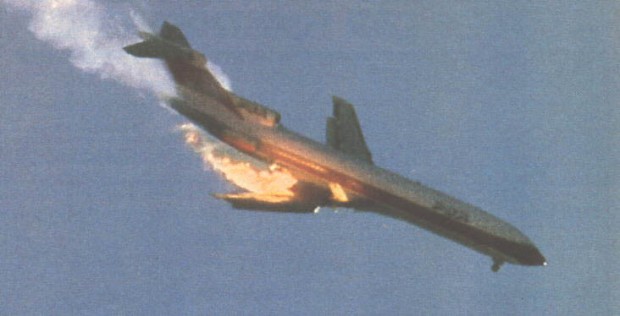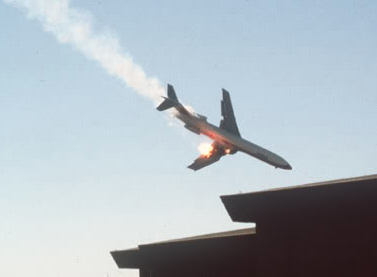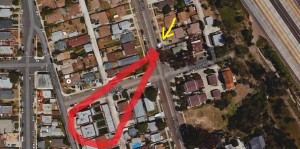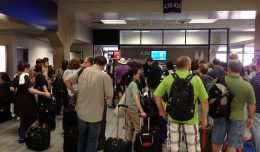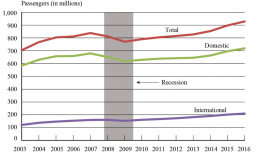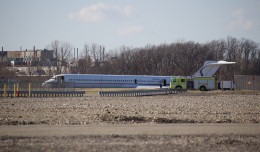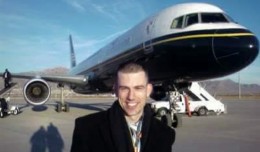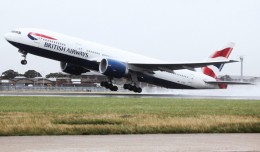WARNING: This article contains gruesome details of a major aviation accident.
It was 37 years ago that Pacific Southwest Airlines (PSA) Flight 182 crashed in San Diego, but the wreck is still heavily etched in the minds of so many. September 25th of 1978 was a very hot but pretty day that would end with what was, at the time, the deadliest air crash in the United States. Aside from its significance in airline history, this crash which resulted from a mid-air collision with a Cessna, is also very well known because of two images caught by photographer Hans Wendt of the aircraft plummeting to Earth with its right wing on fire.
As is always the case within the aviation industry, many lessons were learned as a result of this wreck. In the interest of safety, we as an industry study these accidents to keep them and their lessons in mind as we continue to maintain and appreciate what is today the safest era in airline history.
It is easy for so many to just write-off a plane crash with default feelings of fright and sadness. But I feel that without understanding the horrific realities of these accidents faced by victims, loved ones, first responders and investigators, we do a disservice to their memories. We also then fail to grasp the magnitude of its relevance, avoid complacency and prevent these types of accidents from happening again.
The background
PSA Flight 182 was a flight from LAX to San Diego that originated in Sacramento. These short flights connecting Californian cities made it a popular commuter flight for those that worked for PSA. As a result, over 30 of their own employees were riding as passengers that day.
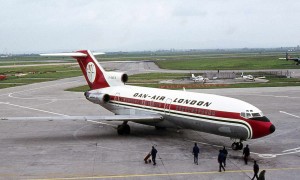
Photo of a 727-100, with some people standing next to it to give you a size comparison, though the one operating PSA 182 was a -200 version, which is about 20 feet longer.
The aircraft was a Boeing 727, which was a very popular airliner for domestic flying from the 70s to the 90s. Its age greatly accelerated the type’s phasing out after the airline industry’s downturn following 9/11, and they currently no longer operate in airline service.
While PSA Flight 182 was descending below 4,000ft, air traffic controllers informed the pilots of a small Cessna flying in the area. The pilots of both aircraft were required to “see and avoid” each other in this environment. Confusing the Cessna with a different aircraft nearby, the PSA pilots did not have this particular Cessna in sight, and they ended up descending right on top of the small propeller aircraft at 2,600ft above the intersection of 38th Street and El Cajon Blvd.
The top of the Cessna hit the bottom of the right wing on the 727, which is where the jet’s fuel tanks are housed. The Cessna exploded and dropped from the sky, landing close by at 32nd Street and Polk Avenue, killing both of the 2 people on board (and thankfully, no one on the ground).
Flight 182’s damage was severe along the right wing, with Wendt’s photos clearly showing damage to the right wing’s leading edge. Damage and fire also crippled the hydraulic systems, preventing control of the aircraft. Useless attempts to correct the right-banking aircraft can be seen in high-resolution versions of the same photos, showing full-deflection of the left aileron.
Here is the transcript of the pilots’ final conversation, starting with confusion as to the location of the nearby Cessna.
NOTE: CAM stands for Cockpit Area Microphone. Each number after CAM references various microphones near different seats in the cockpit that pick up various sounds and voices, usually intra-cockpit communication. The Captain’s was #1, First Officer’s #2, Flight Engineer’s #3, cockpit jumpseat’s #4. “RDO” references radio communication with Air Traffic Control, with the associated number again referencing the seat that it was picked up from.
09.01:11 CAM-2 Are we clear of that Cessna?
09.01:13 CAM-? Supposed to be.
09.01:14 CAM-1 I guess.
09.01:20 CAM-4 I hope.
09.01:21 CAM-1 Oh yeah, before we turned downwind, I saw him about one o’clock, probably behind us now.
09.01:38 CAM-2 There’s one underneath.
09.01:39 CAM 2 I was looking at that inbound there.
09.01:45 CAM 1 Whoop!
09.01:46 CAM 2 Aghhh!
09.01:47 CAM (Sound of impact)
09.01:48 CAM 1 On shit!
09.01:49 CAM-1 Easy baby, easy baby.
09.01:51 CAM-1 What have we got here?
09.01:52 CAM-2 It’s bad.
09.01:53 CAM-2 We’re hit man, we are hit.
09.01:56 RDO-1 Tower, we’re going down, this is PSA.
09.01:58 CAM [sound of stall warning]
CAM-1 This is it baby!
CAM-? [expletive]
CAM-1 Brace yourself.
CAM-? Hey baby…
CAM-? Ma, I love you…
09.02:04 [End of recording]
After the mid-air collision, the aircraft hit the ground 13 seconds later at a nose-down angle of 50 degrees at 300mph. Of the 135 people that were on the aircraft, only 4 bodies were found intact. Crashing into a neighborhood, the 727 destroyed or damaged a total of 22 structures, with 7 people on the ground also perishing (including a couple in an Audi that happened to be driving down that street). Though it was the deadliest U.S. plane crash at the time (144 between the 2 aircraft and on the ground), it only held that title for a mere 8 months until American Airlines Flight 191 crashed in Chicago the following May.
Visiting the site, scaling to size
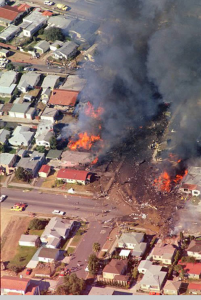
The debris field from PSA 182, from the northeast, looking southwest, in the approximate direction that the aircraft impacted, showing a majority of the field on Dwight Street.
We all know that airliners are large. It can often be difficult to really grasp just how large they are, though, because we usually only see them in the sky or at airports. There are rarely things physically close to aircraft that we can relate to in our daily lives that would allow for a good size comparison. Unfortunately, seeing those comparisons with relatable objects often happens when an airliner is in a place it shouldn’t be…usually after a crash. I recall seeing a photo of the United Airlines Douglas DC-8 that was involved in the mid-air collision over New York City in 1960. The DC-8 is really a medium-sized airliner, but in those images we saw that the top of its tail would be able to reach the roof-height of the 3-story brownstone houses that surrounded it as it sat in the middle of the street. This was also with the tail sitting on the ground, not lifted above it as it would if it were attached to an intact aircraft. That photo really put things into perspective for me.
Understanding that size relation for a highly destructive wreck like PSA 182 was important in what I wanted to learn by visiting the crash site. How big of an area could be physically affected by a medium-sized 727 that impacted the ground at a steep angle and at high speed?
Ahead of time, I studied photos of the debris field and closely looked at maps of the neighborhood of North Park, specifically Dwight and Nile Streets, which is where the ground-impact occurred. It seemed as though the main debris field (not including random parts expelled elsewhere) was confined more or less within a two-block stretch along Dwight Street, west from Nile. Pulling up to the site, however, I immediately noticed that the overall scene was significantly smaller than I had even expected from the photographs.
First, that “two block area” was really just one block. In fact, by eyeballing it, I would say that the entire debris field was only the equivalent of about two-lengths of the 727 itself. On the map, I had mistaken an alleyway for a street, which immediately shrunk what I thought the crash site was by half.
The other part that made the site smaller than I thought had to do with the houses themselves. Aside from the ones that were replaced, the homes in that area are very tiny bungalows, and they are packed in very, very tight next to one another. I could now see how 22 homes were damaged or destroyed in such a small area, all built so close-in to one another.
Point of impact
Research told me that the nose-down impact had compressed the entire 153-foot long fuselage in a small area in the driveway of the second house from the corner on Nile Street. Striking the ground in a right 90-degree right roll (wings fully vertical instead of horizontal), the contents of the aircraft were expelled out of its left side in an “11 o’clock” direction from the front of the residence toward Boundary Street, all in under one second.
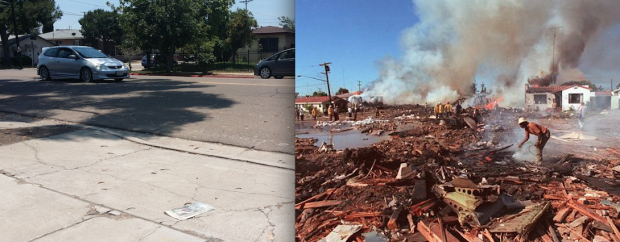
Both images were taken a few feet from each other at the point of impact. The left was taken in 2015, the right was taken on September 25, 1978.
Though the fuselage impacted the driveway, the right wing of the aircraft struck and damaged that home itself. The home at this property was one of the larger ones in the immediate vicinity, and today is one of very few properties in the area that is surrounded by a black gate. Pure speculation, but I wondered if many people visited this site, perhaps trespassed, and the homeowners understandably want to maintain their privacy.
The driveway has some noticeable cracks in it, and though some people say that this is damage from the impact, these sidewalks were all rebuilt after the crash, and the cracks are a result of ground settling. Spray painted on street just in front of the curb are the fading words “You Inspire Beauty.”
Scorched Earth
Standing at the point of impact, I looked Southwest toward the direction of the debris field. Comparing to overhead photos from the crash site, you can see it was a relatively narrow path down the block.
Even without having already known which houses were destroyed in advance, it was obvious which ones had been rebuilt. If it wasn’t a low, narrow, long bungalow…it was probably destroyed by fire that day in 1978, though several homes that I know were burned also look like they may have been repaired as opposed to demolished.

Another side-by-side comparing modern day to that fateful day in 1978. Both images are looking west up Dwight from the southeast corner at Nile Street.
A bulk of the debris field had been on Dwight Street, which goes slightly uphill from the point of impact. It is tough to believe that this block was blackened, reeking with the smell of burned homes, fuel and people. I couldn’t imagine walking this block in the aftermath of the accident. First responders discussed the challenge of every step they took; their boots literally melting while they worried about stepping on any of the human remains that were strewn about.
Fruitless and painful rescue
Before it even hit the ground, help was on the way, with a detective who witnessed the collision having radioed that an aircraft was moments from crashing. Like the pilots’ attempts to save the aircraft, the emergency crews’ attempts were also futile, as there were no injured people to tend to except for a few cuts from some people on the ground. The only thing there was to do was put out fires and keep looters away from the scene.
Several responders quit after the crash. For all of the horrors faced throughout their career, nothing could prepare them for what they saw that day. Several San Diego Police recruits were brought in to assist, with the sights being enough for them to leave the academy, effectively having been police officers for only that one day.
Their grisly accounts painted an awful scene. One detective told of the intact torso wearing a pilot uniform up in a tree. There was also the mother driving nearby with her baby in a rear child-seat, both of whom were covered in blood when a flight attendant’s body came through the windshield. Or the old man who thought an earthquake had taken place, and briefly confused the dead body in the bedroom with his wife.
Attempting to comprehend
Having read documents and seen photos that tell of even more gruesome details, it was tough for me to walk south from Dwight Street down the narrow alley. I also had a serious pit in my stomach when I looked south on the very narrow Boundary Street, where many victims were placed and covered.
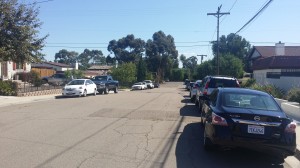
Looking east from the southeast corner of Dwight and Boundary Street, looking down the small hill at the rest of the crash site.
This southeast corner offers a view from the top of the small hill above the rest of the site, back toward the driveway where it all began, the distance not being much longer than a hockey rink. I almost still cannot fathom that an aircraft of that size, striking the ground at such speed, can all be contained within such a small area; this small block just swallowing it up.
Standing there in the present day, it is so incredibly quiet that my spoken words made me feel the need to whisper so as to not interrupt neighbors. The scene now so peaceful, leaving the average, unknowing person clueless as to the horrors that took place at this very location.
Perspective and comprehension are the two most important things to me when I visit a site like this. My visit has allowed me to learn more about what took place that day, though without being there then, or losing someone dear, I could not possible ever fully comprehend it. But again, I aim to memorialize those who left us, share love with their friends and families (I urge you to read the comments on this page), and appreciate the sacrifices that leave us all safer as a result of lessons learned.
From this corner, I look back down the block and up to the sky. As I do so, I imagine the 727 colliding with the Cessna, then with the Earth, the subsequent pain of their loved ones, and the challenges in the grim memories from those brave enough that came to help. More importantly, I also imagine that Flight 182 is still flying in the skies today, with PSA’s 30+ employees and their passengers having the most grand of inflight parties imaginable for all of eternity.
Godspeed, 182. Almost 4 decades later, your sacrifice is not forgotten.
This Friday morning, on September 25th, we will be at the crash site again, joining a group dedicated to remembering PSA 182 in a memorial ceremony. We urge others to join and take part. Please Like their Facebook page, as they are aiming to have a permanent marker placed at the crash site.
Phil Derner founded NYCAviation in 2003. A lifetime aviation enthusiast that grew up across the water from La Guardia Airport, Phil has airline experience as a Loadmaster, Operations Controller and Flight Dispatcher. He currently runs NYCAviation and performs duties as an aviation expert for the media. You can reach him by email or follow him on Twitter.


